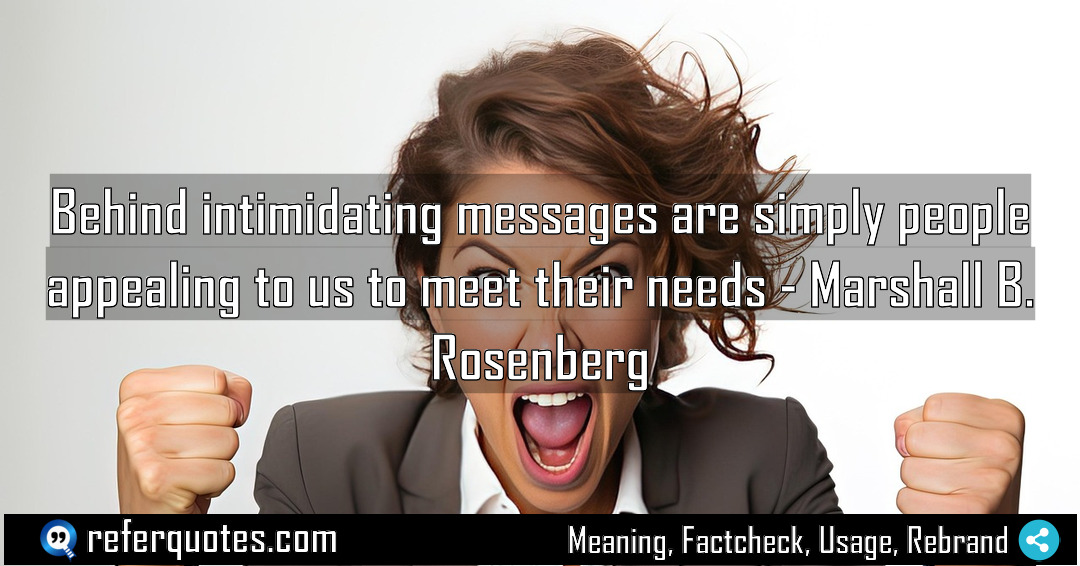
Behind intimidating messages are simply people appealing to us. It’s a game-changer that reframes every difficult conversation you’ll ever have. Once you see it, you can’t unsee it.
Share Image Quote:
Table of Contents
Meaning
At its core, this quote teaches us that aggression is just a clumsy, often fearful, form of communication. It’s a desperate attempt to be heard.
Explanation
Let me break this down for you. For years, I used to get so defensive when someone came at me with anger or criticism. My instinct was to fight back or shut down. But Rosenberg’s framework flips the script entirely. It asks you to listen *through* the noise—the shouting, the blame, the sarcasm—and hear the raw, human need underneath. That colleague who sends that terse, borderline rude email? They’re not a jerk. They’re desperately appealing for respect, for efficiency, for clarity. The partner who snaps at you? They’re likely crying out for connection, for support, for understanding. It’s not about excusing the behavior. It’s about understanding the source. And when you do that, you stop reacting to the attack and start addressing the actual problem.
Quote Summary
Reading Level70
Aesthetic Score75
Origin & Factcheck
This wisdom comes straight from Marshall B. Rosenberg’s seminal book, Nonviolent Communication: A Language of Life, first published in the United States back in 1999. You might see similar sentiments floating around, but this is the original, structured thought. It’s the foundation of his entire NVC model.
Attribution Summary
Where is this quotation located?
| Quotation | Behind intimidating messages are simply people appealing to us to meet their needs |
| Book Details | Publication Year: 1999; ISBN: 9781892005038; Last edition: 3rd Edition (2015); Number of pages: 264. |
| Where is it? | Chapter 6: Requesting That Which Would Enrich Life, Page 101 (2015 edition) |
Context
In the book, this isn’t just a nice idea. It’s a practical tool in a larger system designed to replace our habitual, knee-jerk reactions with conscious, compassionate responses. Rosenberg places this concept right at the beginning, because it’s the fundamental shift in perception you need to make everything else work.
Usage Examples
So how do you use this? Let me give you a couple of real-world scenarios.
First, in leadership. Imagine your team member misses a deadline and instead of apologizing, they send a defensive, blaming message. Instead of firing back about their attitude, you can think, “Okay, behind this intimidating message is an appeal. What’s the need? Maybe for recognition of the obstacles they faced? For more realistic timelines?” Your entire approach changes from punitive to problem-solving.
Second, in personal relationships. Your partner says, “You never listen to me!” That feels like an attack. But if you hear it as an appeal, the need is clearly for connection and to be heard. You’re no longer arguing about the word “never”; you’re addressing the loneliness behind it.
This is for anyone who deals with people—so, everyone. Managers, parents, partners, customer service reps… you name it.
To whom it appeals?
Share This Quote Image & Motivate
Motivation Score80
Popularity Score85
Shareability Score80
FAQ
Question: Does this mean I should just let people walk all over me?
Answer: Absolutely not. That’s the biggest misconception. This isn’t about being a doormat. It’s about being strategic and effective. You hear the need behind the attack, and you address *that*, which is far more powerful and likely to resolve the conflict than just trading insults.
Question: How can I possibly do this in the heat of the moment?
Answer: It’s a muscle. You have to practice. Start by just noticing it in low-stakes situations. The barista is short with you? Instead of getting offended, just wonder, “Huh, I wonder what’s going on with them today.” That tiny pause is the beginning of the practice.
Question: What if the person is just genuinely a difficult person?
Answer: I get it, some people are tough. But think of “difficult” as a style of communication they’ve learned to get their needs met. Their needs are still human—for safety, autonomy, respect. Understanding that doesn’t make their behavior okay, but it can drain it of its power to upset you and help you set clearer boundaries.
Similar Quotes
You know, “The goal of Nonviolent Communication is not” about putting on a polite mask. It’s about getting radically honest with yourself and others, which is often a lot harder…
You know, the objective of Nonviolent Communication isn’t about changing people. It’s a total mindset shift from trying to win to building a genuine connection. It flips the script on…
When we stay with empathy, we allow others to fully express themselves. It’s a game-changer because it removes the fear of judgment. This simple shift transforms how we connect with…
Every shy person has a bold self waiting… it’s a powerful idea, right? It reframes shyness not as a personality flaw, but as a temporary state. It’s about unlocking a…
Daring leaders are not silent about hard things. It’s a truth I’ve seen play out time and again in the most effective teams. This isn’t about grand, heroic gestures but…
